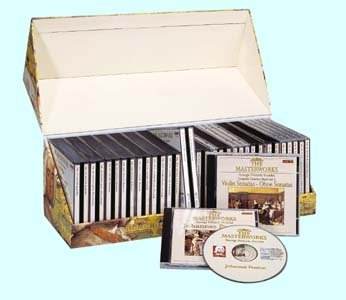Handel was renowned
during his lifetime as a virtuoso organist
and keyboard player. Unfortunately for
us, his art was heavily based on improvisation
so that he left very few highly developed
keyboard pieces, he left no harpsichord
or organ oeuvre in the way that Bach
did.
The organ concerto
form was developed by Handel as an adjunct
to the oratorio. He did not generally
use organ continuo in the operas, but
for the oratorios he tended to use an
organ to support the choruses. The inserting
of organ concertos in between the acts
of the oratorio was a way of providing
extra novelties for the audience. At
the oratorios, the audience could not
rely on novelty and virtuoso display
from the latest Italian singers so Handel’s
performances on the organ were a sort
of substitute.
Luckily for us, from
the 1730s, Handel started to develop
more of an interest in publishing instrumental
music as a way of disseminating his
music. He helped John Walsh with the
publication of the Opus 3 Concerti Grossi
though he did not actually prepare them
for publication. Then in 1738 Walsh
published the Opus 4 organ concerti
which Handel had prepared for publication.
The organ parts are probably only the
merest simulacrum of what he would have
performed live but they are the nearest
thing we have.
The concertos were
not all written specially for the occasion.
Handel was an expert at recycling material
from other sources. The first concerto
in the set was first performed in ‘Alexander’s
Feast’ in 1736 and the second was first
performed in ‘Esther’ in 1735. Its 1st
movement derives from the motet ‘Silete
Venti’ and the 2nd from the
Trio Sonata Op 2. Concerto no. 3 was
first performed during ‘Esther’ in 1735
and is based on Trio Sonata Op. 2 no.
5. The fourth concerto was first performed
during ‘Athalia’ in 1735 and the 1st
movement is based on discarded chorus
from ‘Alcina’. Concerto no. 5 was first
performed during ‘Deborah’ in 1735 and
was adapted from the recorder sonata
Op.1 no. 11. The 6th concerto
was originally written as the Harp concerto
included in ‘Alexander’s Feast’ performed
in 1736. It was only later adapted for
organ.
The Opus 7 concertos
were not published until 1761 and were
assembled by his assistant John Christopher
Smith junior. In these cases the organist
must exercise far more ingenuity in
supplying what Handel has not written
down. Like the Opus 4 concerti, these
had a many and varied origin. Concerto
no. 1 was first performed during ‘L’Allegro’
in 1740 and its 1st movement
includes an independent pedal part.
The 2nd concerto was first
performed during ‘Samson’ in 1743 and
the last movement was based on a rejected
overture for ‘Samson’. Concerto no.
3 was first performed in 1751 during
‘Alexander’s Feast’ and was Handel’s
last orchestral work. The 4th
concerto may have been performed during
the ‘Occasional Oratorio’ in 1746 but
it may have been assembled by Smith
after Handel’s death. The 5th
concerto was first performed in 1750
during ‘Theodora’ and the 6th
was assembled by Smith.
Despite the presence
of pedals in the Opus 7 no. 1, Handel’s
organs were not large in our terms.
After all they had to be transported
into the theatre; these concertos were
not written for church performance.
This gives rise to a problem for performers
as, if the organist is to play on an
instrument similar to one Handel might
have known, then they must be accompanied
by similar scale orchestral forces.
Unfortunately, on this
disc which enterprisingly includes all
the Opus 4 and Opus 7 concerti along
with the ‘Cuckoo and the Nightingale’
concerto, the forces are mismatched.
Ivan Sokol plays a chamber-sized organ.
At least it sounds like that, but there
are no details given on the disc. His
playing is lively and imaginative and
I would be relatively happy with it.
Unfortunately the Slovak Chamber Orchestra’s
playing is in a different style and
on a different scale. Over three CDs
this begins to annoy and I regret that
I cannot really raise much enthusiasm
for this disc. DG have issued Simon
Preston’s recordings of these works
with the English Concert on a 3 CD set
at mid-price. So you might be well worth
trying to acquire this set instead.
Robert Hugill

![]() Ivan Sokol (organ)
Ivan Sokol (organ)![]() BRILLIANT CLASSICS 99777-32/34 [3CDs: 76.24+55.16+58.44]
BRILLIANT CLASSICS 99777-32/34 [3CDs: 76.24+55.16+58.44]